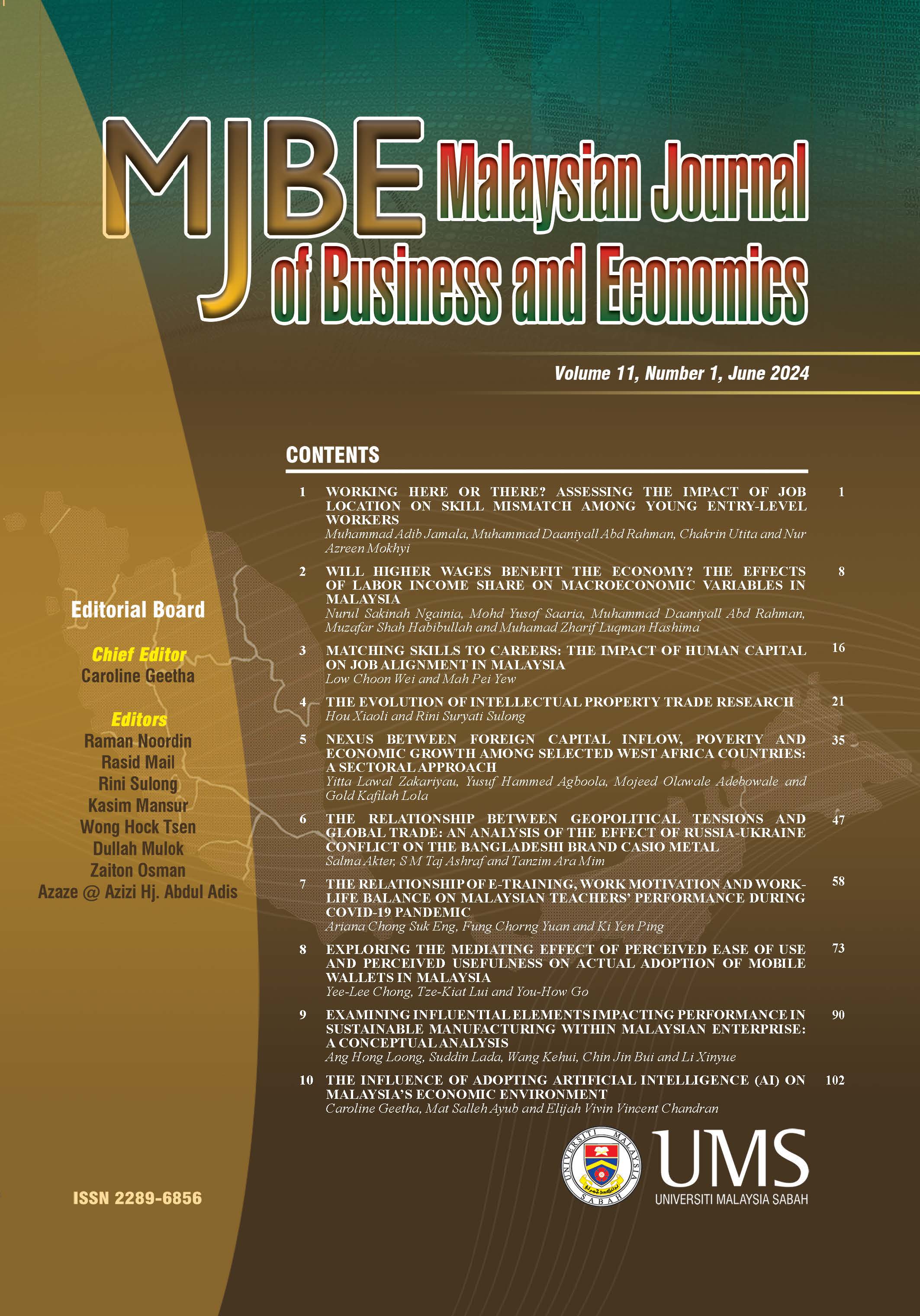WILL HIGHER WAGES BENEFIT THE ECONOMY? THE EFFECTS OF LABOR INCOME SHARE ON MACROECONOMIC VARIABLES IN MALAYSIA
DOI:
https://doi.org/10.51200/mjbe.v11i1.5101Keywords:
labor income, female labor force participation rate, technology adoption, labor productivity, shadow economy, MalaysiaAbstract
In Malaysia, household expenditure drives about 60% of the economy. This suggests that increasing aggregate demand is crucial for economic growth. As demand is a function of labor income, raising the latter puts more money into the pockets of consumers, which eventually facilitates feedback effects on the goods and factor markets and potentially triggers macroeconomic structural changes. Having these effects in hand raises a concern on the extent to which the increase in labor income could influence selected macroeconomic variables, such as shadow economy, female labor force participation rate, technology, labor productivity, foreign workers, and skilled-related underemployment. These are some structural issues pointed out in the Twelfth Malaysia Plan (2021-2025). In the pursuit of achieving targets to increase labor income to GDP from 37.1% in 2020 to 40% by 2025, this paper attempts to examine the impact of labor income on the selected macroeconomic variables using annual data from 2005 to 2021 and employing the Ordinary Least Square (OLS) with robust standard error due to Newey-West procedure. Our results indicate that the labor income could boost female labor force participation rate, labor productivity, and technological innovation. Meanwhile, it is also found that increase in the labor income could dampen the prevalence of shadow economy, skilled-related underemployment, and dependency on foreign workers at various skill levels. Therefore, a policy that targets improving labor income could have greater potential to solve various structural issues inflicted on the nation for decades. Whilst the present study provides empirical evidence on the macroeconomic perspective, it is of great importance for the policy makers to gauge a deeper understanding on such effects at the microeconomic side.
References
Abreu D. S. and Lopes S. (2021). How to Disappear Completely: Nonlinearity and Endogeneity in the New Keynesian Wage Phillips Curve. Applied Econometrics Letters 28 (9), 774-778.
Bank Negara Malaysia. (2021). Outlook and Policy in 2021. Annual Report. Ministry of Finance.
Charpe, M., Bridji S., and McAdam P. (2019). Labor Share and Growth in the Long Run. ECB Working Paper No. 2251.
Department of Statistics Malaysia. (2021). Household Income & Basic Amenities Survey Report 2020. Putrajaya: Department of Statistics Malaysia.
Department of Statistics Malaysia. (2022). Wages in Malaysia: The Story Behind the Statistics. Newsletter. Putrajaya: Department of Statistics Malaysia
Department of Statistics Malaysia. (2022a). Gross Domestic Product Income Approach 2021. Putrajaya: Department of Statistics Malaysia.
Department of Statistics Malaysia. (2022b). Labour Force Survey (LFS) Time Series Statistics by State, 1982-2021. Putrajaya: Department of Statistics Malaysia.
Ibarra, C. A., and Ros J. (2019). The Decline of the Labor Income Share in Mexico, 1990-2015. World Development 122, 570–584.
Karabarbounis, L., and Neiman B. (2014). The Global Decline of the Labor Share. TheQuarterly Journal of Economics 129 (1), 61–103.
Kindler A. Golo N. and Solomon S. (2016). Stochastic Agent-Based Simulation of the Role of Labor in the Economy. Complex Systems, Sustainability and Innovation. Chapter 6.
Georgiadis A. (2013). Efficiency Wages and the Economic Effects of the Minimum Wage: Evidence from a Low-Wage Labour Market. Oxford Bulletin of Economics and Statistics. 75:6. 962-979.
Growiec J. (2012). Determinants of the Labor Share, Eastern European Economics, 50:5, 23-65.
Growiec, J., McAdam P., and Mućk J. (2018). Endogenous Labor Share Cycles: Theory and Evidence. Journal of Economic Dynamics and Control 87: 74–93.
Lee J. and Wie D. (2015). Technological Change, Skill Demand, and Wage Inequality: Evidence from Indonesia. World Development. 67. 238-250.
Lupu D., Cărăusu D. and Ifrim M. (2022). Wage share and economic growth: evidence from Eastern Europe, Applied Economics Letters, 30(6), 772-779.
Riley, R. and Bondibene, C.R. (2017). Raising the Standard: Minimum Wages and Firm Productivity. Labor Economics, 27-50.
Schneider, F. (2011). The Shadow Economy and Shadow Economy Labor Force: What Do We (Not) Know?. Discussion Paper 5769. Institute for the Study of Labor, Bonn.
Zakariya, Z. (2014). Wage Effect of Over-education and Mismatch in Malaysia: A Random Effect Approach. Jurnal Ekonomi Malaysia, 48, 3-17.
Downloads
Published
Versions
- 30-06-2024 (2)
- 30-06-2024 (1)
How to Cite
Issue
Section
License

CCBY (Attribution)
https://creativecommons.org/licenses/by/4.0/
© Universiti Malaysia Sabah 2025
All rights reserved. No part of this publication may be reproduced, distributed, stored in a database or retrieval system, or transmitted, in any form or by any means, electronic, mechanical, graphic, recording or otherwise, without the prior written permission of Universiti Malaysia Sabah Press, except as permitted by Act 332, Malaysian Copyright Act of 1987. Permission of rights is subjected to the journal.









